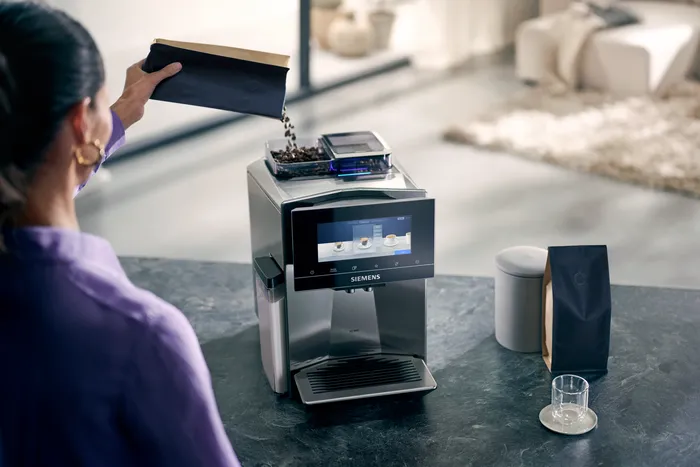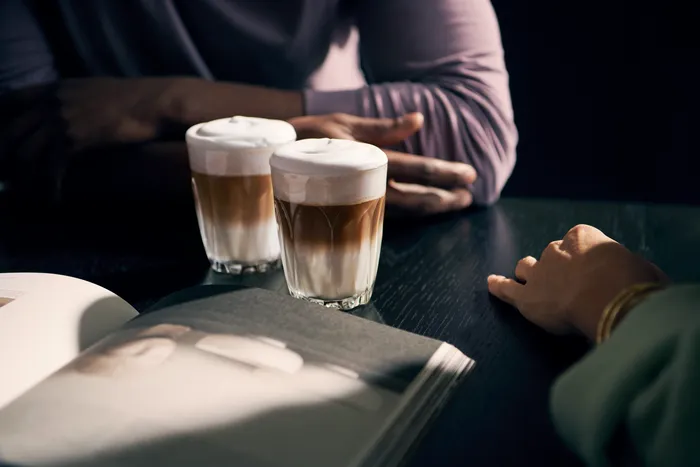What does it take to get the finest nuances out of a coffee bean? How can we create the perfect taste to match our individual preference? When it comes to rich coffee flavour, there are several determining factors and tweaks – starting with the right choice of beans, followed by adjusting and synchronising brewing parameters. Looking at French press, moka pot, or hand filtering, there are several traditional brewing methods available that allow us to adjust parameters like contact time, brewing temperature, and the amount of coffee used – and thus adjust taste. However, as most of us are no baristas or familiar with the details of brewing methods like the before mentioned, there’s a simpler solution: the new Siemens EQ900. Thanks to our most advanced coffee technology, it enables us to discover the fine nuances of coffee-making, tweaking the aroma to our personal taste – with the convenience of a fully automatic espresso machine. But first, let’s look at where great coffee starts.
Starting from the roots: the right choice of high quality coffe beans
The two most popular and common coffee bean types in the commercial coffee industry are Arabica and Robusta. There are major differences in their taste depending on where the beans grow.
- Arabica beans are cultivated in East and Central Africa, India, Indonesia, and Latin America. The natural conditions at the mountainous altitudes make the beans develop slower and more nutrient-dense. This process enhances the complex flavours and increased acidity Arabica coffee is known for. Arabica coffee beans create an elegant, mild, fine, and aromatic coffee with a complex taste. Its aroma is usually dominated by delicate and sweet aromas with tones of berries, sugar, and a pleasant fruity acidity.
- Robusta coffee, mostly grown in Central and West Africa and parts of Southeast Asia, is usually strong, rich, and powerful. It has more of a chocolate taste, a little darker, woody, and more bitter than Arabica. In addition, Robusta beans contain twice the caffeine content of an Arabica bean.
Looking at the different characteristics of the different bean types’ taste, we can choose our preferred nuance before we start brewing coffee. As the EQ900 is equipped with a dualBean container, we have our two favourite coffee bean types at hand to choose from whenever we start preparing our favourite coffee specialties. However, every bean requires a different interplay of brewing parameters to optimally unleash the finest flavours it has to offer. Let’s look at the different brewing parameters and which effects adjusting them can have.


Brewing the perfect cup of coffee
Water and coffee quantity, grind size, as well as contact time, brewing temperature, and pressure: the interplay of these variables plays a major part in unleashing fine aromas for a rich and satisfying coffee taste.
Water and coffee ratio
The ratio of coffee to water is a decisive factor in coffee making. In general, we can say: the higher the amount of coffee, the stronger and more varied it is.
Grind
The grind size is measured in particle size in millimeters. It ranges from superfine 0.1 mm (used in Turkish coffee) up to a rather coarse grind with 1.5 mm (for cold brew). To find our perfect grind, we need to follow our taste. If the coffee tastes watery and acidic, the grind might be too coarse. Choosing a finer grind can improve the brew. An overly bitter taste can be a sign of a too fine grind. Choosing a coarser grind creates a milder coffee taste. However, contact time and brewing temperature affect the flavour as well.
Contact time
The time the water is in contact with the coffee grounds has a major impact on extraction and flavour. The longer the contact time, the more nuances can be unleashed. Thus, a too long contact time can result in a flat, bitter beverage, whereas a too short contact time can lead to your coffee tasting sour and watery with little sweetness. Here, the perfect interplay with the grind is important: finely ground coffee has a larger surface area than coarser coffee, so far more ingredients can be extracted.
Brewing temperature
The water temperature impacts the extraction of flavour and other valuable compounds like oils and caffeine from the coffee grounds. Only the correct temperature allows us to unleash the coffee’s rich, full aroma. Usually, the ideal brewing temperature is between 90 and 95 degrees Celsius. If the temperature is too low, the coffee’s flavour will be restricted, too high, and the coffee tastes bitter and burnt.
Choosing the right temperature also depends on the roasting as darker versus lighter roastings react differently to brewing temperatures. Since lighter roasts are naturally more acidic, they can tolerate higher temperatures of 93-95 degrees Celsius. With dark roasts, however, this temperature would emphasise the bitterness too strongly. Therefore, they usually require a temperature of 91-92 degrees Celsius.
Brewing pressure
Controlling the amount of pressure with which water is forced through the compacted bed of ground coffee is crucial to creating a perfect coffee taste. The pressure allows oils and important components to dissolve out of the powder. In general, a lesser pressure creates a slower flow, a higher pressure creates a faster flow. This means, that setting a higher pressure gives less time for ingredients to be extracted which results in fewer and weaker flavours.
Adjusting these parameters with traditional brewing methods might be challenging. With the new EQ900, coffee lovers can now be their own baristas.
Creating a coffee we can truly call ours
The EQ900 supports our desire for perfect coffee moments. The baristaMode is the heart of the fully automatic espresso machine, enabling us curious coffee lovers to adjust all brewing parameters to our individual taste. We can experiment with all brewing parameters mentioned above and can also adjust the milk quantity for more finesse. The innovative beanIdent technology supports this process : first, we choose the coffee bean type used via the large touch screen. Afterwards, beanIdent automatically identifies the optimal settings for all brewing parameters for the specific coffee bean. This ensures we always find the perfect settings for every coffee bean type we have chosen and every coffee specialty we want to enjoy. Thus, the EQ900 enables us to unleash even the finest aromas – while still leaving us full flexibility to further make individual adjustments thanks to the baristaMode. There are no limits to brewing creativity – ensuring perfect coffee results, fascinating coffee moments, and unleashed aromas to satisfy the curious coffee connoisseur. Of course, each creation can be saved as a favourite to have it ready for later with a tap on the touch screen.
For those who want easy access to excellent coffee or who first want to get a feel for personalising their beverage, Siemens engineers created the comfortMode as an alternative to the baristaMode. In the comfortMode, the EQ900 will automatically brew perfect coffee – all controlled by the intelligent technology inside.
The EQ900 – satisfies all needs of us curious coffee connoisseurs. Discover more.



